Vujovich Design Build – The Idea Farm: New Home Gold
|
|
|
|
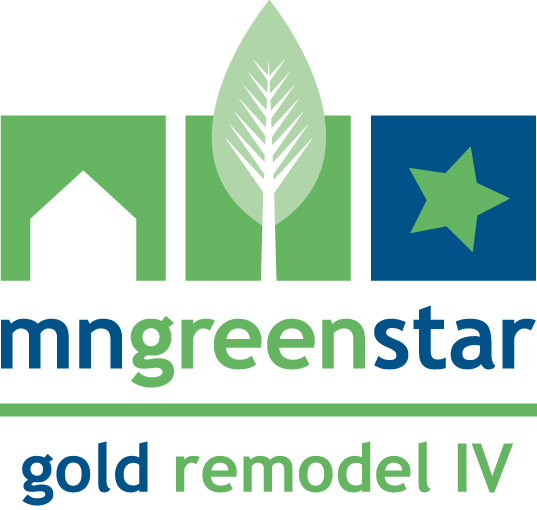 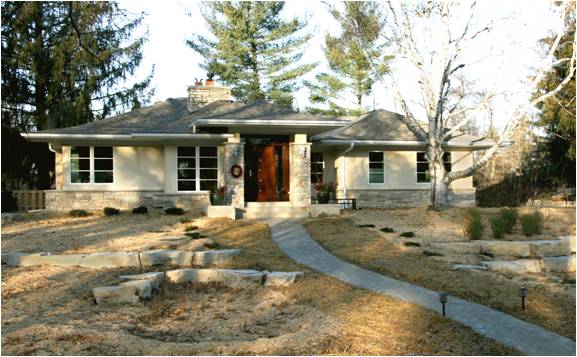
Live Green, Live Smart’s The Sustainable House TM is a participant in Minnesota GreenStar’s Remodeling pilot program and the LEED for Homes Pilot ProjectTM. Live Green, Live Smart has transformed an ordinary post-War rambler in a suburban neighborhood into a Century hour that will be energy efficient, environmentally healthy, respectful of the natural environment, and comfortable for family life as climate and energy resources alter in the coming decades. Environmentally-Conscious Applications The green building materials and techniques as applied to the House are less conspicuous than alternative energy sources, but no less important to our Platinum remodel.
By Peter Lytle, Live Green Live Smart
For more information on this project visit http://livegreenlivesmart.org. |
Sustainable architecture is nothing if it’s not deeply rooted in the surrounding community. Whether it’s sculpture by a local artist or an intimate concert at the Cedar Cultural Center, 7west (1800 Washington) celebrates the satisfying connections that come from Seven Corners living. For residents, LEED is a seal of quality, providing peace of mind that they are living in a home designed to deliver fresh air indoors and improved water and energy efficiency.
The 7west building has several green features that its renters find attractive. Each floor has recycling and organic composting available for the tenants. Green roofs and terraces provide relaxing greenspace, while a white membrane roof provides additional energy efficiency.
 The building also features a passive solar design and high efficiency lighting. Tenants are encouraged to utilize alternative transportation with convenient onsite bike storage set in an easily walkable community. The apartments are located within a half mile of public transit services which provide at least 60 rides per week day. However, those that do drive vehicles regularly are provided garage space with continuous exhaust to minimize pollutants that could leak into the residence and affect the indoor air quality. Inside the apartments Low-VOC paints hardwood flooring, and sustainable cabinetry provide for a healthy, natural, and sensible interior environment.
The building also features a passive solar design and high efficiency lighting. Tenants are encouraged to utilize alternative transportation with convenient onsite bike storage set in an easily walkable community. The apartments are located within a half mile of public transit services which provide at least 60 rides per week day. However, those that do drive vehicles regularly are provided garage space with continuous exhaust to minimize pollutants that could leak into the residence and affect the indoor air quality. Inside the apartments Low-VOC paints hardwood flooring, and sustainable cabinetry provide for a healthy, natural, and sensible interior environment.
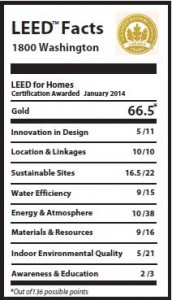
The Buildings landscaping was created with 100% drought tolerant plants. Rain barrels provide the irrigation needed to water the green roof and plants. As a former brownfield this lot has come a long way. Additional LEED points were awarded to the project for its density of 100.9 units per acre.
That’s just the start. Sunny gathering spaces, private study nooks, yoga and fitness studios, and common areas with billiards, fire pits, and entertainment centers recognize that many residents need a respite from the stress of daily life. Innovative Chinese Feng shui design creates a positive atmosphere. The LEED verification team included Jimmie Sparks, Rick Cobbs, and Jason LaFleur of Eco Achievers.
Download and Share the 1800 Washington Project Profile – PDF
recently partnered with Michigan State University (MSU) to perform a Post-Occupancy Evaluation (POE) of 235 LEED-certified homes in the Midwest, and we are pleased to share the results. The goal is to identify the homes’ actual performance after people moved in, and also the
benefits and shortcomings of the current LEED for Home certification system. The survey consisted of various categories including (1) general satisfaction with the LEED-certified home, (2) satisfaction about the home in general and various aspects of the indoor environment, (3) overall well-being including the health impact, (4) energy efficiency and building performance, (5) the environmental behavior of residents, and (6) demographics.
The findings of this study revealed that most residents of the LEED-certified home were satisfied with their home and their quality of life in their home.
Continuing Education
This webinar is free to review. If you are interested in continuing education credits, you must follow the following steps:
1. Watch the webinar presentation by Eunsil Lee, PhD for FREE.
2. Contact to take the quiz and score at least 80% to be approved. Please also post a comment below and help add to the conversation.
3. Pay the fee below to get your certificate and CEUs. You must be an member to pay the reduced member fee.
Two methodological approaches were used for this study. Qualitative case studies were conducted with 15 LEED-certified Habitat for Humanity residents in Kent County, Michigan through in-depth interviews, observations, and IEQ measurement. 16 % respondents came from LEED-certified Habitat for Humanity homes in Michigan. These residents in particular, were more satisfied with their homes and their quality of life than residents of Non- Habitat homes were, although their satisfaction with their neighborhood and specific aspects of home environment (e.g., space layout, size of space, finishes, visual privacy, view, temperature, humidity) was lower than that of Non-Habitat residents. Residents of the Habitat for Humanity tended to perceive the improvement of their quality of life since moving into their LEED-certified home more strongly than residents of the Non-Habitat home did. They were also more satisfied with energy efficiency of their home than residents of the Non-Habitat home.
2 page graphic summary of Study PDF Here
Full 96 Page Report on Post Occupancy Study
Promote sustainability in low-income housing: More programs should be developed that can offer incentives for participation in LEED green building certification programs and increase funding opportunities to cover the initial costs of sustainable home building for low-income families at both state and local levels, because those efforts will produce long-term economic and environmental benefits.
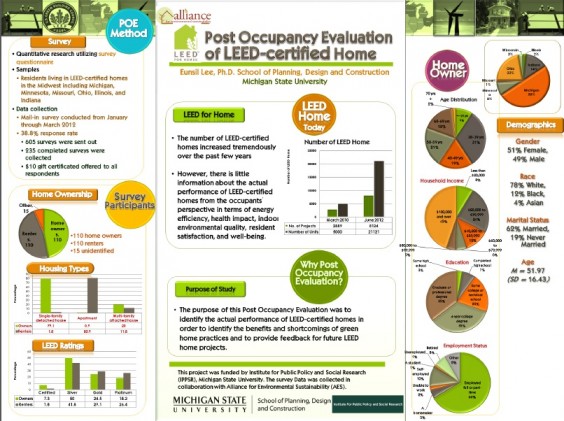
Improve the design of low-income green housing: Architects, designers, engineers, contractors, and facility managers can gain greater understanding of design and the performance of low-income green homes with the findings of this POE project by receiving feedback for the future projects. Although the houses were LEED-certified, some problems in maintaining the green features, building performance, and comfortable home environment were identified. Architects, designers, engineers, green policy makers, and Habitat for Humanity Affiliates should pay attention to the specific needs relevant to these issues to improve the design quality of low-income green home through the process of planning, design, and construction.
Implement Post-Occupancy Evaluation (POE): More extensive implementation of POEs is critical. Since LEED certification is based on “as-designed” performance, further implementation of POEs is exceptionally important to verify actual performance and expected performance. In particular, since there is no mandatory post-occupancy evaluation process included in LEED or other green home certifications, there is no empirical data to verify whether these green homes perform satisfactorily in terms of heating, cooling, or indoor environmental quality.
Contribute to the general body of knowledge: Although there is a consensus about the benefits of green homes, few empirical studies about the actual effects of LEED-certified green homes on residents’ health, comfort, and satisfaction have been conducted. The findings from this study therefore increased understanding of the benefits to be gained from LEED-certified low-income homes by applying empirically tested, research -based knowledge.
Promote public awareness: This report will educate the public about the impact of LEED-certified homes on (1) improving the residential environmental quality and energy efficiency, (2) reducing residents’ health risks and (3) enhancing residents’ comfort and satisfaction by disseminating the results of this research at conferences and by publishing articles in scholarly and extension journals.
Make a Policy Recommendation:
1) Incentives for green homes, such as LEED-certified homes, Energy Star Homes, or National Association of Home Builders’ Green certified homes, should be offered to developers, contractors, and homeowners. This will be critical for both new and existing homes located in the cold regions such as Michigan to encourage energy-efficient green home constructions for low-income families in order to offer lower utility bills.
2) Policy makers should collaborate closely with local builders and developers to apply more green home features to new or existing low-income houses. Certain types of incentives for local builders and developers are desired.
3) Post-occupancy evaluations of green certified homes should be encouraged, particularly for low-income housing. Continuous efforts should be made to save energy and keep green homes energy-efficient for these households and homeowners.
4) We suggest conducting POEs of green certified homes in five or ten years to preserve their green features and energy efficiency. Based on the POEs, the homes may or may not be repaired to keep the original functions of green features. In the POEs and repairing process, local home remodeling companies can be involved. Some incentives should be considered for the local companies or businesses to be involved in this green process if they are small or micro businesses. Tax reductions for these types of companies (i.e., energy auditors, window replacement companies) can promote small entrepreneurs working on sustainable housing projects in local communities. This can create more local jobs.
5) We suggest offering regular educational seminars for residents of green certified homes in order to offer precise information about the green features of their homes and educate them how to keep their homes green. On-site seminars can be offered one or two times in the development phase and right before the new owners take occupancy. Once residents move to their new homes, it is recommended to send flyers via mail or email to remind them of the green features of their homes and inform them of how to use and maintain these features. Mailed or emailed flyers will work better than on-site seminars because many residents have full- or part-time jobs.
6) In addition, incentives should be considered for upgrading low-income housing to make it more energy-efficient and environmentally friendly. Currently there is a 500 dollar maximum tax credit for upgrading any housing features to make them energy-efficient. This maximum should be increased to keep up with the real cost of upgrading energy-consuming HVAC systems to energy-efficient ones. In particular, more aggressive incentives should be offered to households below a certain income level so that homeowners can be more active in upgrading their conventional houses to energy-efficient green ones.
Thanks to the Michigan Applied Public Policy Research (MAPPR) Grant from the Institute for Public Policy and Social Research (IPPSR) and Michigan State University (MSU) who worked with to perform this Post-Occupancy Evaluation (POE).
See more details on a similar LEED Pre-Occupancy Report.
Using his home building expertise, Brian Bosgraaf started Cottage Home in 2000 specializing in building custom homes along Lake Michigan. Cottage Home has designed and built more than 70 custom homes along the West Michigan shoreline, including 13 LEED certified homes. In an interview with Brian, he expressed his passion for LEED certification and sustainable construction practices.
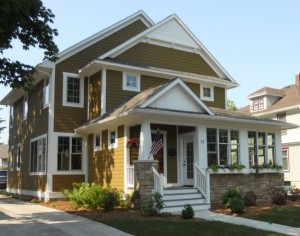 When Brian and Jeremy vanEyk (Vice President) were asked about their commitment to building LEED, they responded that Cottage Home is committed to utilizing healthy, affordable, efficient, and durable construction practices that are already above code, energy star and even LEED at times. Brian says he considers LEED only one of the many tools in his toolbox. Other such tools include creative design, customer service, careful selection of materials, and creating a sense of place. In order to make it simple for the customer, Cottage Home uses a fixed price prior to starting construction which already includes LEED qualifications. This allows some of the cost of LEED certification to be absorbed by both the customer and through the Cottage Homes marketing budget. Brian believes this method works due to his design and construction teams working together throughout the construction process, which creates a feedback loop that fosters constant improvement. Including LEED certification into the final cost helps facilitate more sales than presenting each option with separate pricing.
When Brian and Jeremy vanEyk (Vice President) were asked about their commitment to building LEED, they responded that Cottage Home is committed to utilizing healthy, affordable, efficient, and durable construction practices that are already above code, energy star and even LEED at times. Brian says he considers LEED only one of the many tools in his toolbox. Other such tools include creative design, customer service, careful selection of materials, and creating a sense of place. In order to make it simple for the customer, Cottage Home uses a fixed price prior to starting construction which already includes LEED qualifications. This allows some of the cost of LEED certification to be absorbed by both the customer and through the Cottage Homes marketing budget. Brian believes this method works due to his design and construction teams working together throughout the construction process, which creates a feedback loop that fosters constant improvement. Including LEED certification into the final cost helps facilitate more sales than presenting each option with separate pricing.
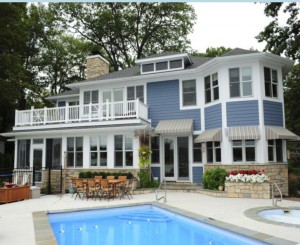 Since many homeowners today are educated and concerned about sustainability and environmental issues, many take time to study the details of LEED on the website of Cottage Home and take comfort in knowing LEED is a third party certification. Clients are aware of LEED’s achievements and credibility, and often wonder about how changes to the house affect the LEED certification level. Much of Cottage Home’s customer base is from the Chicago area where LEED is prevalent in their office buildings, and a result, many clients have experienced the advantages offered by LEED construction firsthand. These clients have often already invested in commercial LEED projects and are now ready to transition these same high standards to their personal lives. Jeremy decided to experience the benefits of LEED firsthand and chose to have his own house in Zeeland, certified LEED Platinum.
Since many homeowners today are educated and concerned about sustainability and environmental issues, many take time to study the details of LEED on the website of Cottage Home and take comfort in knowing LEED is a third party certification. Clients are aware of LEED’s achievements and credibility, and often wonder about how changes to the house affect the LEED certification level. Much of Cottage Home’s customer base is from the Chicago area where LEED is prevalent in their office buildings, and a result, many clients have experienced the advantages offered by LEED construction firsthand. These clients have often already invested in commercial LEED projects and are now ready to transition these same high standards to their personal lives. Jeremy decided to experience the benefits of LEED firsthand and chose to have his own house in Zeeland, certified LEED Platinum.
 Building on the lake front comes with complications such as extreme wind loads, humid changes, temperature fluctuation, and other variables. To overcome these challenges, Cottage Home uses high performance home measures to control the entire process though design, build, and some maintenance which allows more control of green features. Cottage Home designs and builds what is right for each particular home which may result in homes varying in different HVAC, insulation, passive solar heating, and various climate control systems. One particular feature that is commonly used in these homes, including Jeremys, is an ERV (Energy Recovery Ventilator). An ERV automatically exhausts stale air from the inside of the house and replaces it with fresh air from the outside. Another key feature used in many of the homes is a geothermal system. There are a few different types used, but all contribute to the energy efficiency of the homes in some way. Several techniques are used to increase water efficiency in the homes, such as tankless water heaters, which only heat water when necessary, water collection systems to help with sprinking and irrigation, and faucets and showerheads that work with less water than traditional ones. Insulation, as well as materials such as flooring, home furnishings and walls are all aspects that need to be carefully considered when building these homes.
Building on the lake front comes with complications such as extreme wind loads, humid changes, temperature fluctuation, and other variables. To overcome these challenges, Cottage Home uses high performance home measures to control the entire process though design, build, and some maintenance which allows more control of green features. Cottage Home designs and builds what is right for each particular home which may result in homes varying in different HVAC, insulation, passive solar heating, and various climate control systems. One particular feature that is commonly used in these homes, including Jeremys, is an ERV (Energy Recovery Ventilator). An ERV automatically exhausts stale air from the inside of the house and replaces it with fresh air from the outside. Another key feature used in many of the homes is a geothermal system. There are a few different types used, but all contribute to the energy efficiency of the homes in some way. Several techniques are used to increase water efficiency in the homes, such as tankless water heaters, which only heat water when necessary, water collection systems to help with sprinking and irrigation, and faucets and showerheads that work with less water than traditional ones. Insulation, as well as materials such as flooring, home furnishings and walls are all aspects that need to be carefully considered when building these homes.
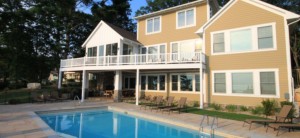 As leaders in the industry we asked Brian and Jeremy what they saw in the future of design and construction. Jeremy believes that being able to evaluate the effectiveness of high performance systems and insulation through energy bills is important. Along with water collection systems to reduce storm water runoff and help irrigate the lawn. Brian agrees that we should have a system to allow clients to ensure they are getting the most effective homes. He foresees homes that can be manipulated to meet the client’s needs at any given time. An example of this would be homes with the ability to accommodate a family of four, which can then transition to accommodate sleeping arrangements for twenty. Along with being able to better meet a client’s needs, he would like to see energy loads distributed to only sections of the house in use, as well as the ability for clients to control how energy is used throughout the home (on site and from satellite locations). Cottage Home sees one challenge to moving forward with these ideas is getting sub-contractors to approach basic air sealing, insulation, proper HVAC sizing, and design aesthetics with an effective mindset. Cottage Home has established themselves as innovators and leaders in the design of luxury LEED lake front homes. They continue to partner quality, design and the environment hand in hand to produce sustainability along our beaches.
As leaders in the industry we asked Brian and Jeremy what they saw in the future of design and construction. Jeremy believes that being able to evaluate the effectiveness of high performance systems and insulation through energy bills is important. Along with water collection systems to reduce storm water runoff and help irrigate the lawn. Brian agrees that we should have a system to allow clients to ensure they are getting the most effective homes. He foresees homes that can be manipulated to meet the client’s needs at any given time. An example of this would be homes with the ability to accommodate a family of four, which can then transition to accommodate sleeping arrangements for twenty. Along with being able to better meet a client’s needs, he would like to see energy loads distributed to only sections of the house in use, as well as the ability for clients to control how energy is used throughout the home (on site and from satellite locations). Cottage Home sees one challenge to moving forward with these ideas is getting sub-contractors to approach basic air sealing, insulation, proper HVAC sizing, and design aesthetics with an effective mindset. Cottage Home has established themselves as innovators and leaders in the design of luxury LEED lake front homes. They continue to partner quality, design and the environment hand in hand to produce sustainability along our beaches.
Quick Numbers – Average HERS Score 51 Average LEED score 75
Learn & see more about their LEED projects below.
 Many states are in the process of adopting in whole or with modifications the 2012 International Energy Conservation Code (IECC). This new code raises the bar in construction design for residential and commercial structures, and as a result, architects / engineers / contractors building to the new code will be affordably offer a choice to their clients for pursuing several above-code certifications such as Energy Star and LEED without too much additional effort or cost.
Many states are in the process of adopting in whole or with modifications the 2012 International Energy Conservation Code (IECC). This new code raises the bar in construction design for residential and commercial structures, and as a result, architects / engineers / contractors building to the new code will be affordably offer a choice to their clients for pursuing several above-code certifications such as Energy Star and LEED without too much additional effort or cost.
The new national energy code includes mandatory blower-door testing for building air leakage (less than <3.0 ACH at 50 pascals), which will measure how well contractors have sealed up penetrations between the outdoors and indoor conditioned space. This testing will be required for all projects permitted after the new code goes into effect. Some states have made modifications to the adopted code, such as Illinois which has changed the ACH rate to 5.0 ACH @ 50. View our archived July 12 webinar to learn more about IL Energy Code changes.
Other aspects of the 2012 IECC such as requiring hot water pipe insulation and mechanical ventilation are new items that projects will need to implement. Learn more on a free webinar held Thursday July 12.
So, how do national IECC 2012 requirements relate to voluntary above-code programs like Energy Star, LEED and Passive House? Pretty well actually. has assembled a matrix identifying several energy-related items as written in the code and indicated what the impact or requirements would be in one of these above-code third-party green certification programs. Download national comparison matrix as PDF.
(Illinois-specific modifications are shown in the image below)
What does this mean? Well just by building to the new code, these projects will be very close to meeting the Energy Star for Homes program requirements, and will score very well in programs that require Energy Star version 3 such as LEED or Green Communities. Other green programs that don’t require Energy Star, such as National Green Building Standard or local green home programs will also heavily reward these projects.
LEED for Homes will be requiring Energy Star version 3 beginning at the end of the year, so right now a project can still earn LEED certification by building to Energy Star version 2 requirements which should be easily met on any home that meets IECC 2012.
Take advantage of this sweet spot and earn market recognition by attending a LEED workshop or sign up to earn LEED certification today!
After dozens of new and gut-rehab LEED projects, the Grand Rapids, Michigan Habitat for Humanity affiliate is ready to begin a new era. That happens to be a really old era too. 
With LEED for Homes-registered project #100, Habitat for Humanity of Kent County will start work on their ambitious “Wealthy Heights” neighborhood effort to rebuild homes built in the 1880’s as affordable, workforce housing. After building one new LEED platinum home (Grand Rapid’s 1st!) and preserving a single-family home and a two-unit in Wealthy Heights over the last couple years, Habitat is ready to start seven more projects this fall. It will also coincide with major road and infrastructure improvements by the City of Grand Rapids. Neighbors in Wealthy Heights get ready for construction season!
“The neighbors and business owners who have led the revitalization effort in this neighborhood over the last three decades made it possible for Habitat to step into the mix. Being historic has been a challenge and a blessing but now become a really desirable location for our home buyer partner families,” said Habitat’s Chris Hall.
As Director of Strategic Initiatives, Hall has been part of this project since 2009 when it was first brought to Habitat. With a history of results, Habitat Kent was in the right place at the right time. “It all happened as we were starting to look at ways to become more effective in transforming entire neighborhoods through our work.”
Since then, Habitat has completed the three home projects but also built a community garden and hosted an AmeriCorps Signature Service Project which offered basic exterior repairs, landscaping and a fresh coat of paint for home owners on Donald Place SE.
“We’ve seen residents show up at hearings in support, out working on site, and they have embraced our new families as part of the neighborhood. For-profit builders are doing work in the neighborhood too. This week I heard from folks as far away as New York City regarding a possible LEED-ND certification. Considering we haven’t even begun the major work yet you’d have to say it’s already been an amazing success story.”
After committing to 100% LEED for Homes certification in 2007, Habitat Kent has gone one to become recognized internationally as a leader in affordable, sustainable design and construction. In fact, they were awarded for “Outstanding Program Commitment” to LEED for Homes at the 2011 Greenbuild Conference and Expo in Toronto.
While the positive energy surrounding this project is building, Hall says there is still opportunity for you to help, “We are always looking for partners—either through financial contributions, donations of materials or professional services, as volunteers on site and even as home buyers.” Anyone can visit habitatkent.org to find out more. “Someone can even gain LEED project experience to use toward a LEED AP credential through Habitat! Anyone interested sustainable design will find something cool about this project.”
Future posts will feature a profile of the 100th registered home at 327 Freyling Place SE as well as the other upcoming and completed projects.
Research is being done by MSU and FSU students and faculty with support from Dow and Habitat. They begin with the lowest cost and simplest forms of energy efficiency including cans of spray foam at joints and in gaps, spray foam in rim joists, and other air sealing measures. From there they will test other wall insulation and mechanical system combinations. At each step the homes are tested and analyzed.
Habitat Director of Strategic Initiatives Chris Hall enjoys seeing young people included in the project, “The Michigan State and Ferris State students have really been on the frontline the whole way and they’re getting their hands dirty—in a good way. What they’re learning will directly be applied to what they do in their careers in architecture, engineering, construction management or beyond. And that their work on these homes specifically will benefit a low-income family is especially cool.”
More details on the research project https://greenhomeinstitute.org/wp-content/uploads/2012/06/Black-Hills-Home-Energy-Research-Project-Habitat-for-Humanity-Kent-County-.pdf
Want to learn more about affordable Green/LEED major rehabs to existing homes? Free recorded webinar on Habitat’s success here https://www.fuzemeeting.com/replay_meeting/50e23e6d/2385117 Need CEUs for watching this? Email us Info@allianceES.org
This home designed by the architect Eric Hughes, Image Design is located east of Kingsley Michigan approximately 20 minutes from central Traverse City. Built in 2009 this home was the Renewable Energy Tour Home for the 2009 Michigan Energy Fair and was awarded the 2009/10 Insulating Concrete 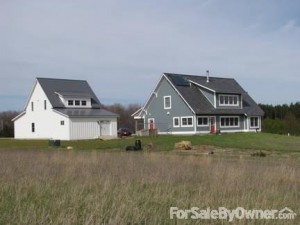 Form Association National Gold Award for Small Residential Construction. This home is located on a quiet dirt road with easy access to M113, Traverse City, and Cadillac. State forest and public lands are within easy walking distance. Countryside views abound and it doesn’t get much quieter. In addition to a LEED Gold rating the home received a 5+ Energy Star certification and a HERS score of 48. The links below provide detailed information on the energy saving features of the home. This is not a short sale.
Form Association National Gold Award for Small Residential Construction. This home is located on a quiet dirt road with easy access to M113, Traverse City, and Cadillac. State forest and public lands are within easy walking distance. Countryside views abound and it doesn’t get much quieter. In addition to a LEED Gold rating the home received a 5+ Energy Star certification and a HERS score of 48. The links below provide detailed information on the energy saving features of the home. This is not a short sale.
Primary Features:
* 3 bedrooms including master suite on main floor.
* 2.5 baths * Main floor laundry (washer and dryer included).
* 2010 and 2011 total utility bills averaged $1048 annually or $87.38/month.
* Buildblock insulated concrete form walls.
* Anderson 400 windows.
* Soytherm spray foam insulation.
* Toto dual flush ADA compliant toilets.
* Cement fiberboard siding.
* Premium Kasselwood metal roof shingles.
* No mechanical HVAC, a Tulikivi masonry stove provides soothing radiant heat with backup electric baseboards. (www.tulikivi.com, model TTU2700 with bake oven)
* The entire house has been heated by roughly 7-10 face cords of hardwood firewood per winter. Wood was cut from the property (ash and sugar maple), purchased commercially this would be roughly $425.
* One fire a day is sufficient for 95% of the heating season. No constant stoking required.
* Energy star ceiling fans provide all the “AC” you ever need.
* Window overhangs allow in winter sun but block summer sun.
* Maple, tile, and polished concrete flooring throughout.
* Solar hot water system with 85 gallon insulated Marathon electric water heater.
* No-VOC paints, floor treatments, and caulks.
* Energy Star refrigerator (included) and washer.
* Soapstone countertops.
* 80% efficiency whole house Heat Recovery Ventilator (filters included).
* Pre-wired for future wind turbine installation. Fantastic wind generator site with no obstructions.
* External plug and wiring ready for a full size home generator.
* Home architectural plans available upon request.
Garage:
* Built summer 2011.
* Detached 3 stall garage with a 12′ x 12′ basement and adjacent 12′ x 12′ stone floored ventilated root cellar.
* 24′ x 24′ loft over the middle two stalls designed to be finished for guest quarters or home office.
* North stall could be used for storage, tractor, or third vehicle. South stall could easily be finished as a workshop.
* Cement fiberboard siding and standing seam metal roof.
* Large double doors facing the garden for easy entry/exit with garden equipment.
* Plans available for enclosed walkway between garage and house mudroom.
Additional Features:
* Organic garden, fruit trees, nut trees, raspberries, and asparagus planted
* Built in entertainment center and kitchen seating/storage
* Programmable in floor radiant electric heat in all bathrooms
* Automatic dog door
* Fantastic birding site with nesting eastern meadowlarks, bobolinks, upland sandpipers, northern harriers, American woodcock, and others commonly seen from the back windows.
* Additional acreage available includes 25 acres of northern hardwoods managed for sustainable timber production and wildlife habitat. 7 acres of native warm season grasses were planted in 2011. Deer and turkeys are harvested every year from this property. Owner is a wildlife habitat biologist.
* Great neighbors and countryside views.
More information and pictures of the home can be found at the following links. All pictures were taken prior to additional improvements and construction of the detached garage and root cellar. Cut and paste links into your browser.
LEED Certification score sheet and description
Northern Express article on the home.
http://www.northernexpress.com/michigan/article-4582-leeding-the-way_green-homes.html
2009 Michigan Energy Fair Renewable Energy Home Tour:
http://www.glrea.org/events/MichiganEnergyFair2009/RE.html
See Listing http://www.forsalebyowner.com/listing/PER61
More project Details & Design Firm: http://www.bbaworld.com/pages/Press/Press-Releases/LEED.html

Habitat for Humanity Kent County has won this years Green Build 2011 Award for Outstanding Program Commitment to LEED for Homes. is proud to have served Habitat for Humanity in Kent County since their commitment in 2007 to Build all LEED for Homes Silver certified projects. Habitat Kent County has been raising the bar and is completing Gold LEED certified projects and they are on their way to complete a platinum. Currently they have achieved
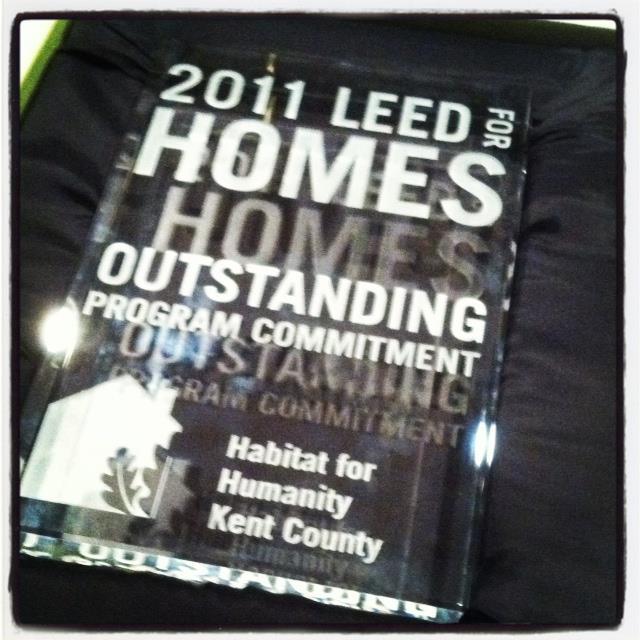
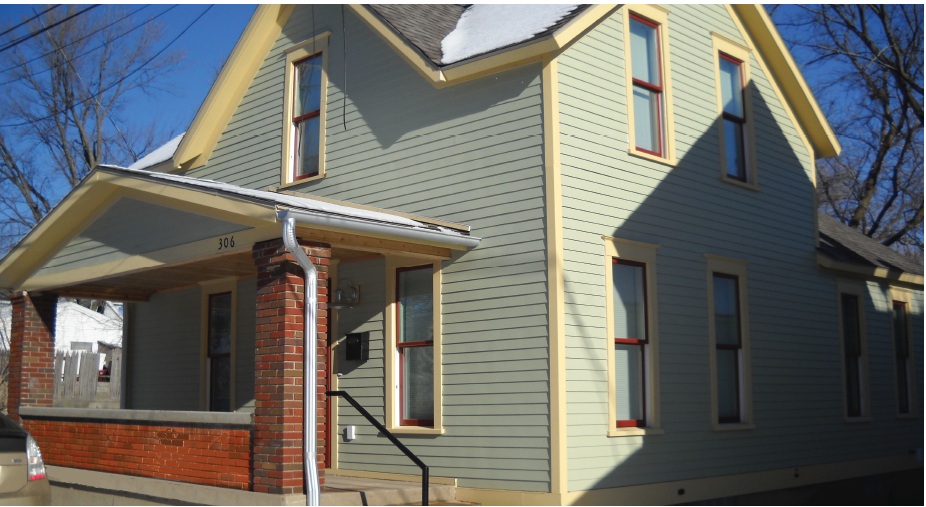 The 53 HERS score for this home was, at the time, the most energy efficient home built by Habitat Kent. This is noteworthy since the home is over a century old and was originally built to “breathe” so achieving such air-tightness wasn’t easy. This success is even more impressive considering the untrained, inexperienced labor-force of volunteers who rehabbed the home. Simply being located in a historic district also invited numerous challenges including using
The 53 HERS score for this home was, at the time, the most energy efficient home built by Habitat Kent. This is noteworthy since the home is over a century old and was originally built to “breathe” so achieving such air-tightness wasn’t easy. This success is even more impressive considering the untrained, inexperienced labor-force of volunteers who rehabbed the home. Simply being located in a historic district also invited numerous challenges including using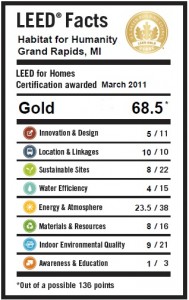 wood windows (which are notoriously inefficient). Despite these challenges, the project team hit a home run with this home. Their recent dedication to be restorative to the Wealthy Heights Community has lead to several projects that involved painting, remodeling, gut rehabbing, as well as building several new homes and creating community gardens. Habitat is completely revitalizing the area. Their highest achievement here is their commitment to constructing a net zero or near zero (currently) 5 bedroom home. This home features, ICF and SIP panel construction and has a solar hot water heater attached to the house. The homes HERS score tested out to be 35, one of the lowest in Michigan. They are still missing the Solar PV making a perfect promotion opportunity for any company willing to supply solar to this project. Please contact Chris Hall if you are interested. CJHall@habitatkent.org. Due to Habitat for Humanity of Kent Countie’s commitment to LEED certification, they have been able to attract many more sponsors, donors and volunteers. They have also been able to achieve some great accomplishments. Deconstruction of homes literally saves tons of usable materials and items from heading to the landfill. These materials are re-sold at the Habitat
wood windows (which are notoriously inefficient). Despite these challenges, the project team hit a home run with this home. Their recent dedication to be restorative to the Wealthy Heights Community has lead to several projects that involved painting, remodeling, gut rehabbing, as well as building several new homes and creating community gardens. Habitat is completely revitalizing the area. Their highest achievement here is their commitment to constructing a net zero or near zero (currently) 5 bedroom home. This home features, ICF and SIP panel construction and has a solar hot water heater attached to the house. The homes HERS score tested out to be 35, one of the lowest in Michigan. They are still missing the Solar PV making a perfect promotion opportunity for any company willing to supply solar to this project. Please contact Chris Hall if you are interested. CJHall@habitatkent.org. Due to Habitat for Humanity of Kent Countie’s commitment to LEED certification, they have been able to attract many more sponsors, donors and volunteers. They have also been able to achieve some great accomplishments. Deconstruction of homes literally saves tons of usable materials and items from heading to the landfill. These materials are re-sold at the Habitat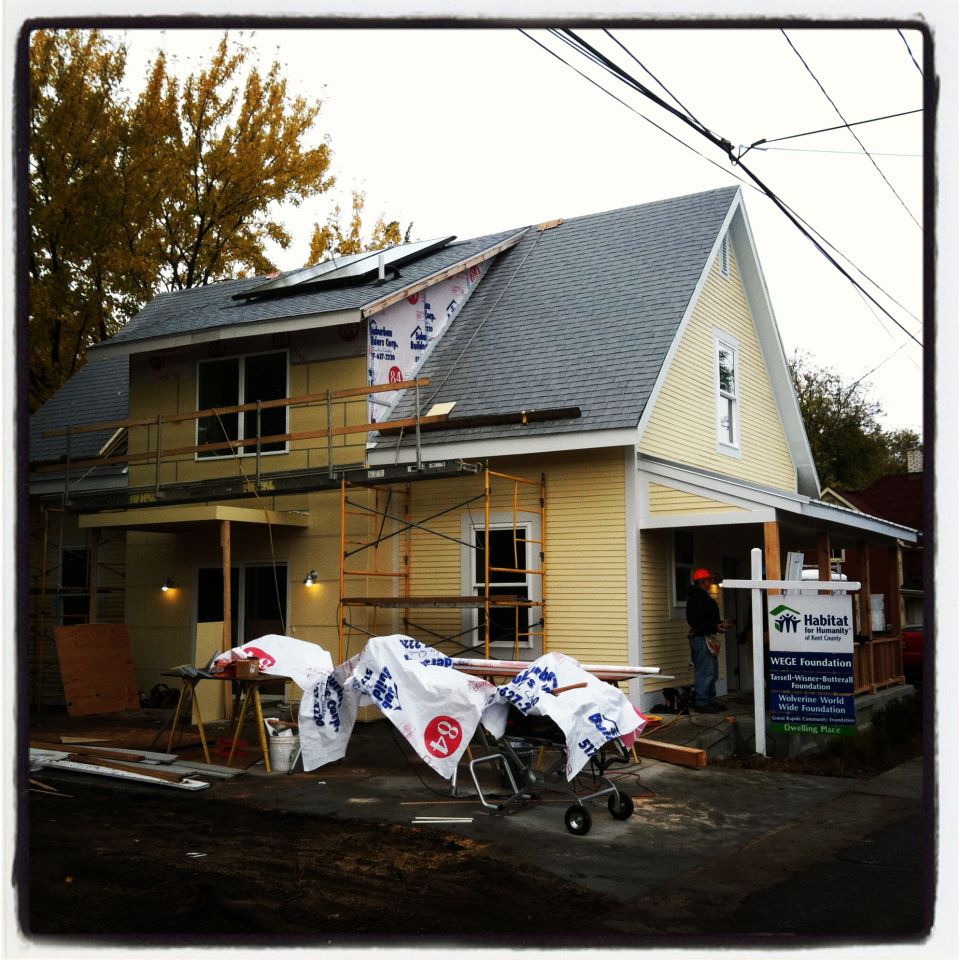 ReStore for a profit to build other homes. Habitat discovered that it costs approximately $8000 more to incorporate green building and zero-step entry into a Habitat home building per house, and that the long-term benefits to the family and the environment easily justify the expense. It is estimated (based on their earliest LEED Homes) that annual savings costs for electric, water, and heating will be at least $1,000 per home per year. The extra money available every month eases the hard decision “food or heat?” for families who live close to the poverty line. Over the life of each homebuyer’s 25 year mortgage, the savings equates to $25,000 at minimum – money a family is able to invest into strengthening their future.Looking to start a LEED for Homes or a Green Building project within your Habitat Affiliate? Please contact today. We work with over 20 other Habitat Affiliates including Detroit, Chicago, Cincinnati and Indianapolis.
ReStore for a profit to build other homes. Habitat discovered that it costs approximately $8000 more to incorporate green building and zero-step entry into a Habitat home building per house, and that the long-term benefits to the family and the environment easily justify the expense. It is estimated (based on their earliest LEED Homes) that annual savings costs for electric, water, and heating will be at least $1,000 per home per year. The extra money available every month eases the hard decision “food or heat?” for families who live close to the poverty line. Over the life of each homebuyer’s 25 year mortgage, the savings equates to $25,000 at minimum – money a family is able to invest into strengthening their future.Looking to start a LEED for Homes or a Green Building project within your Habitat Affiliate? Please contact today. We work with over 20 other Habitat Affiliates including Detroit, Chicago, Cincinnati and Indianapolis.
GreenHome Institute
ATTN José Reyna
1451 Lake Drive SE, #6484
Grand Rapids, MI 49516
Tel: (616) 458-6733
Email: info@greenhomeinstitute.org
